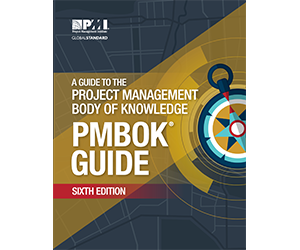
Most projects require some form of external purchasing (procurement) in order to meet their goals. Executing these procurements to fulfill the needs of the project falls under the knowledge area of Project Procurement Management.
Contractors usually have better expertise or experience and can provide a higher quality product. But often they are not motivated by the same factors as the project team. Delivering their portion of the work on time or under budget requires the active involvement of the project manager.
Successful sub-contracting requires knowledge of the types of contracts available, as well as how to write them. Requests for Proposals, Invitations to Tender, and the like must be drawn up, as do the contracts themselves. This is a significant amount of knowledge, and many firms outsource even those tasks to law firms, engineers, etc.
- Plan Procurement Management
- Conduct Procurements
- Control Procurements
Plan Procurement Management
During the project planning phase the procurement needs of the project are identified. For each external vendor requirement, a Statement of Work is composed which is known by many names (Terms of Reference, Scope Statement, etc.) but serves as a written statement of what work the contractor will do. Procurement documents normally consist of a Request for Proposal, Invitation to Tender, or the like, with the Statement of Work included as an attachment. Thus it is the guiding document to the project team and the more specific it is, the better the boundaries of each organization’s work is defined. Additionally, the procedures used to solicit proposals and/or bids as well as the decision making criteria are determined at this stage. Potential sellers are identified and preferred vendors might be contacted. All of this information is compiled into a Procurement Management Plan, a subset of the overall Project Management Plan.
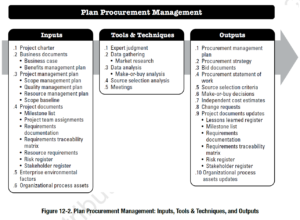 Inputs
Inputs
- Project charter
- Business documents
- Business case
- Benefits management plan
- Project management plan
- Scope management plan
- Quality management plan
- Resource management plan
- Scope baseline
- Project documents
- Milestone list
- Project team assignments
- Requirements documentation
- Requirements traceability matrix
- Resource requirements
- Risk register
- Stakeholder register
- Enterprise environmental factors
- Organizational process assets
Tools & Techniques
- Expert judgment
- Data gathering
- Market research
- Data analysis
- Make-or-buy analysis
- Source selection analysis
- Meetings
Outputs
- Procurement management plan
- Procurement strategy
- Bid documents
- Procurement statement of work
- Source selection criteria
- Make-or-buy decisions
- Independent cost estimates
- Change requests
- Project documents updates
- Lessons learned register
- Milestone list
- Requirements documentation
- Requirements traceability matrix
- Risk register
- Stakeholder register
- Organizational process assets
Conduct Procurements
Once the procurement needs of the project are identified and procurement procedures are determined, the procurements are executed. Requests for Proposal (RFP’s) or Invitations to Tender are sent out, and responses are analyzed. Selection criteria should be determined in advance. Agreements are signed and the project management plan is updated with the new cost/budget and schedule information obtained from the vendor.
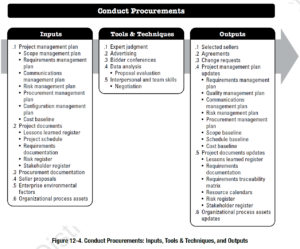 Inputs
Inputs
- Procurement management plan
- Scope management plan
- Requirements management plan
- Communications management plan
- Risk management plan
- Procurement management plan
- Configuration management plan
- Cost baseline
- Project documents
- Lessons learned register
- Project schedule
- Requirements documentation
- Risk register
- Stakeholder register
- Procurement documentation
- Seller proposals
- Enterprise environmental factors
- Organizational process assets
Tools & Techniques
- Expert judgment
- Advertising
- Bidder conferences
- Data analysis
- Proposal evaluation
- Interpersonal and team skills
- Negotiation
Outputs
- Selected sellers
- Agreements
- Change requests
- Project management plan updates
- Requirements management plan
- Quality management plan
- Communications management plan
- Risk management plan
- Procurement management plan
- Scope baseline
- Schedule baseline
- Cost baseline
- Project documents updates
- Lessons learned register
- Requirements documentation
- Requirements traceability matrix
- Resource calendars
- Risk register
- Stakeholder register
- Organizational process assets
Control Procurements
Poor subcontractor management can cause budgets and schedules to spiral out of control and derail projects when everything else has been executed flawlessly. During regular project status intervals, the project manager must review subcontractor agreements, progress updates, and work performance information as necessary to ensure that subcontractors are on pace to meet their budget and schedule commitments. It is not enough to assume that subcontractors are “good at what they do” and will meet their contractual obligations. When subcontractors mismanage their work, everyone loses, including the contracting organization. Thus, project managers should be aware of the status of subcontractor work and make the appropriate change requests and project management plan updates as early as possible.
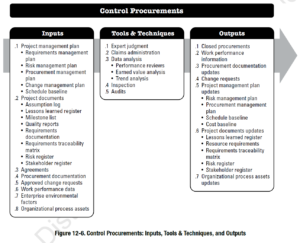 Inputs
Inputs
- Project management plan
- Requirements management plan
- Risk management plan
- Procurement management plan
- Change management plan
- Schedule baseline
- Project documents
- Assumption log
- Lessons learned register
- Milestone list
- Quality reports
- Requirements documentation
- Requirements traceability matrix
- Risk register
- Stakeholder register
- Agreements
- Procurement documentation
- Approved change requests
- Work performance data
- Enterprise environmental factors
- Organizational process assets
Tools & Techniques
- Expert judgment
- Claims administration
- Data analysis
- Performance reviews
- Earned value analysis
- Trend analysis
- Inspection
- Audits
Outputs
- Closed procurements
- Work performance information
- Procurement documentation updates
- Change requests
- Project management plan updates
- Risk management plan
- Procurement management plan
- Schedule baseline
- Cost baseline
- Project documents updates
- Lessons learned register
- Resource requirements
- Requirements traceability matrix
- Risk register
- Stakeholder register
- Organizational process assets updates





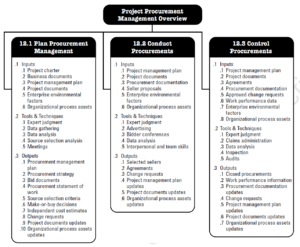

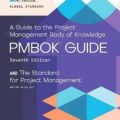


 David Maynard says
David Maynard says
October 30, 2018 at 8:28 pmI’m not clear why a STRATEGY is the output of a PLAN. According to the dictionary “A strategy is a careful plan or method” It seems like the two words are virtually interchangeable.
However, it’s clear in the PMBOK guide that a strategy results from a plan.
What is the difference between a Procurement STRATEGY and a Procurement PLAN?
 Dave Litten says
Dave Litten says
December 14, 2018 at 2:49 amIt is unfortunate that PMBOK uses the word PLAN for each of the Knowledge Areas first processes.
They are clearly showing the “how” – which is a STRATEGY.
Take the Risk Management Plan as an example, it is all about HOW you will apply risk management to this project and therefore HOW you will use/tailor/blend, the remaining risk management processes.
Perhaps a better phrase to use would be The Risk Management APPROACH, which would immediately resolve this confusion!
Dave Litten
https://www.projex.com/pmp